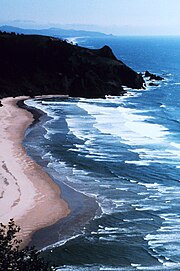Cascade Head
| Cascade Head | |
|---|---|
Nature Conservancy |
Cascade Head is a headland and 102,110-acre (41,320 ha)
UNESCO - Man and the Biosphere Programme
Originally established in 1976, through UNESCO's Man and the Biosphere Programme, the Cascade Head Biosphere Region (formerly known as the Cascade Head Biosphere Reserve) was expanded during the 2016 reauthorization to its current footprint. Within its boundaries are the Cascade Head Scenic Research Area, Cascade Head Experimental Forest, the Cascade Head Preserve, and the Cascade Head Marine Reserve and Marine Protected Areas. The diverse ecosystem includes the Salmon River and its estuary, a sandy littoral spit, densely forested coastal rainforest, a two-mile basalt headland covered in native coastal prairie and marine reserve stretching west into the waters of the Pacific. As with modern biosphere regions, there are core protected areas, areas of managed use, and areas of cooperation within the boundary.
The Nature Conservancy
In the early 1960s, volunteers organized an effort to protect Cascade Head from development. By 1966 they had raised funds and purchased the property, and then turned it over to The Nature Conservancy. Because of its ecological significance, Cascade Head Preserve and surrounding national forest and other lands won recognition in 1980 as a National Scenic Research Area[1] and a United Nations Biosphere Reserve.[2][3]
Conservancy researchers are testing methods of maintaining and restoring grassland habitat for the
Experimental Forest

The 11,890-acre (4,810 ha) Cascade Head Experimental Forest was established in 1934 for scientific study of typical coastal Sitka spruce-western hemlock forests found along the Oregon Coast. The forest stands at Cascade Head have been used for long-term studies, experimentation, and ecosystem research since then. In 1974 an act of Congress established the 9,670-acre (3,910 ha) Cascade Head Scenic Research Area that includes the western half of the experimental forest, several prairie headlands, the Salmon River estuary to the south, and contiguous private lands.[4]
Before the establishment of the experimental forest in 1934 and for sometime after, an intense forest inventory was done to determine distribution, age classes, and volumes of major tree species. Early research at Cascade Head includes studies that determined life history and characteristics of native tree species; growth and yield of
Research on the Salmon River estuary has been ongoing since the first
Flora and fauna

Cascade Head is home to many native plant species, including
Ninety-nine percent of the world's population of the
Geology
Cascade Head is an extinct, uplifted volcano that was once under the Pacific Ocean.
See also
- UNESCO Cascade Head Biosphere Region
- Cascade Head Biosphere Collaborative
- Nature Conservancy
- Siletz Reef
- Sitka Center for Art and Ecology
References
- ^ "Table 11--National Scenic--Research Areas by State – Oregon Cascade Head Siuslaw NF". Retrieved 2016-05-24.
- ^ a b c d "Cascade Head". Archived from the original on 2007-01-26. Retrieved 2007-12-19.
- ^ "Biosphere Reserve Information: Cascade Head". Man and the Biosphere Programme. Retrieved 2011-08-09.
- ^ Cascade Head Experimental Forest and Scenic Research Area Archived 2007-08-18 at the Wayback Machine homepage
- ^ "Cascade Head Experimental Forest and Scenic Research Area Environs". Archived from the original on 2007-02-11. Retrieved 2007-12-20.
- ^ "Oregon - Cascade Head Preserve". The Nature Conservancy. Retrieved 2016-05-24.
